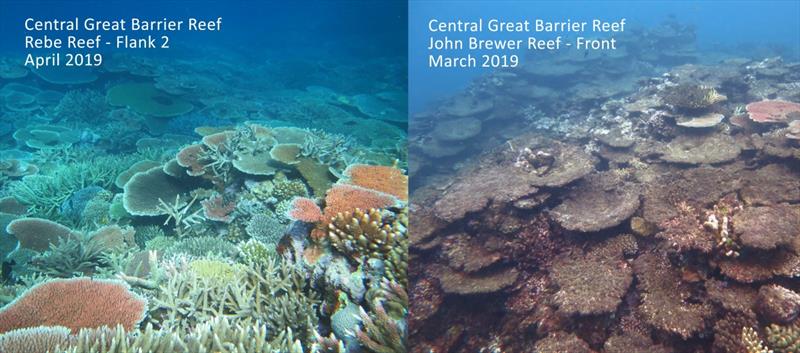
Great Barrier Reef gets mixed bill of health in annual update
by GBRMPA 12 Jul 2019 22:08 UTC

Great Barrier Reef gets mixed bill of health in annual update © GBRMPA
With the Great Barrier Reef under stress from increasingly frequent disturbances, the latest health check shows the Reef needs more time to recover.
The Australian Institute of Marine Science's annual Great Barrier Reef Condition Update report released today, shows mixed results for coral cover across the Northern, Central, and Southern Great Barrier Reef.
AIMS Long Term Monitoring Program leader and ecologist Dr Mike Emslie said this year's report showed hard coral cover continued to decline in the central and southern Great Barrier Reef, while the northern region has stabilised.
AIMS has monitored the Reef for more than 30 years and holds Australia's largest coastal, ocean and reef-related data sets providing a continuous record of change in reef communities.
"Our long-term monitoring has shown that 10 years after Tropical Cyclone Hamish caused widespread damage in the southern region, particularly in the Capricorn-Bunkers in 2009, these reefs are still recovering," Dr Emslie said.
He said while there was a return of hard coral cover at some reefs, major disturbances such as crown-of-thorns starfish outbreaks, cyclones, and coral bleaching events in the past five years had caused a general decline in coral cover across much of the 2300km reef system, which runs along Australia's East coast.
"Despite these impacts we still found healthy reefs in some of the central areas such as the outer shelf reefs off the Whitsundays, and in the southern regions, but overall there has been a slight decline in coral cover in these areas," Dr Emslie said.
A devastating outbreak of crown-of-thorns starfish in the Swain Reefs, has resulted in declines in average coral cover on these reefs last year. Declines in the Swains were offset by continued recovery in the Capricorn-Bunkers, resulting in an overall 1% loss of coral cover in the entire southern region.
"We know reefs can recover given time and the right conditions, but there has been little relief from disturbances in recent years to allow significant recovery to occur," Dr Emslie said.
AIMS CEO Paul Hardisty said the Great Barrier Reef was an important national icon and it contributed $6.4 billion a year to the economy, providing more than 64,000 permanent jobs.
"The Great Barrier Reef is still beautiful and it is resilient, but it is facing unprecedented challenges," Dr Hardisty said.
"Long-term monitoring of this dynamic and very large marine ecosystem allows us to better understand what we can do to help it survive into the future."
AIMS' recorded the highest average coral cover in the Northern region of 30% in 1988, compared with 14% this year. The central region's highest recorded average coral cover was 22% in 2016 compared with 12% this year, and the southern region had 43% in 1988, compared with 24% this year.
AIMS' long-term monitoring provides information on the status and trends of the GBR to reef managers.
See the latest Great Barrier Reef Condition Update Report here
Coral cover by region
Northern Region - Reefs between Cape York and Cooktown
Average coral cover across the region increased slightly from 11% in 2017 to 14% in 2019
Some individual reefs had less than 10% coral cover, while others had moderate (10-30%) to high (30-50%) levels.
Current level remains close to lowest recorded since 1985
The region has suffered cyclones, two severe bleaching episodes and outbreaks of crown-of-thorns starfish in the past 5 years.
Central Region -Reefs from Cooktown to Whitsundays
Average coral cover across the region decreased from 14% in 2018, to 12% in 2019
Coral loss can be attributed to Tropical Cyclone Debbie in 2017 and the current crown-of-thorns-starfish outbreak.
Some outer-shelf reefs of the Whitsundays increased coral cover and remain in good condition, but others closer to the coast were more severely impacted by TC Debbie and have low coral cover.
Southern Region Reefs from below Whitsundays to just north of Bundaberg
Coral cover declined from 25% in 2018 to 24% in 2019
Reefs in the Capricorn-bunker group continued to recover from TC Hamish in 2009. This area escaped bleaching and crown-of-thorns starfish outbreaks.
The Swain group of reefs suffered large coral loss due to intense crown-of-thorns starfish outbreaks.